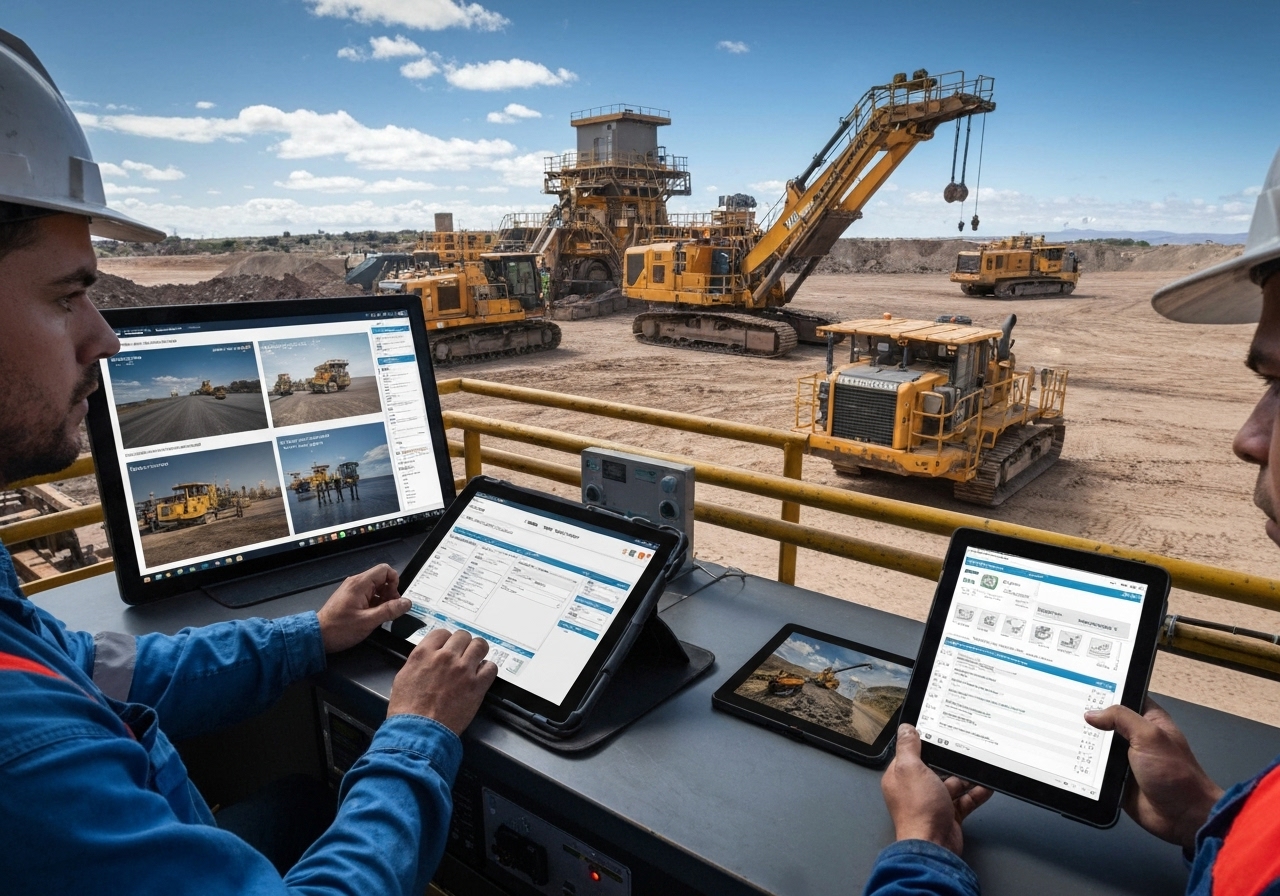Unearthing Efficiency: ERP Software for Modern Mining Operations
The mining industry, a cornerstone of global economies, faces unique challenges: volatile commodity prices, remote operations, stringent regulations, and complex supply chains. To navigate these, mining companies are turning to Enterprise Resource Planning (ERP) software tailored for their needs. These integrated platforms streamline operations, enhance decision-making, and boost profitability across the mine life cycle. This post explores the evolution of ERP in mining, its key features, benefits, and how it’s shaping the industry’s future, alongside insights from mining executives and tech vendors on social media.
A Brief History of ERP in Mining
ERP systems have roots stretching back over a century, beginning with paper-based manufacturing tools like the Economic Order Quantity model in 1913. The 1960s saw mainframe-driven Material Requirements Planning (MRP) systems, which evolved into MRP II in the 1980s, integrating manufacturing tasks like purchasing and scheduling. By the 1990s, ERP emerged as a comprehensive solution, unifying finance, procurement, and operations. In mining, early adoption focused on financial systems to track costs and budgets. These standalone tools, while useful, created data silos, as geological, production, and logistics data remained fragmented across disparate software.
The early 2000s marked a turning point. Mining companies, grappling with global expansion and regulatory pressures, demanded integrated platforms. Vendors like SAP, Oracle, and IFS developed mining-specific ERP solutions, incorporating modules for exploration, asset management, and compliance. These systems centralized data, breaking down silos and enabling real-time insights. Today, cloud-based ERP platforms leverage AI and IoT, offering predictive analytics and scalability to meet the industry’s dynamic needs.
The Rise of Mining-Specific ERP
Mining-specific ERP emerged to address the industry’s unique challenges: remote operations, heavy equipment maintenance, and complex logistics. Unlike generic ERP, these platforms integrate mining workflows—exploration, extraction, processing, and transport—into a single system. By eliminating data silos, they provide a unified view of operations. For example, real-time data from IoT sensors on haul trucks syncs with financial and maintenance modules, enabling proactive decision-making.
Key players like SAP ERP for Mining, IFS Applications, and Pronto Xi offer tailored features. SAP, used by 92% of Forbes Global 2000 mining companies, integrates environmental compliance and safety workflows. IFS excels in asset-intensive industries, optimizing equipment lifecycles. Pronto Xi, deployed in over 40 countries, emphasizes rapid implementation and connectivity in remote mines. These platforms have transformed mining from a fragmented, reactive industry into a data-driven, efficient one.
Key Benefits and Modules of Mining ERP
Mining ERP solutions deliver a suite of modules designed to streamline operations and ensure compliance. Below are the core components and their benefits:
- Resource and Project Management: Tools for resource evaluation (e.g., JORC-compliant reporting) and mine planning optimize extraction. Project management features track milestones, allocate personnel, and ensure budgets align with timelines.
- Logistics and Transport Optimization: ERP streamlines supply chain logistics, optimizing route planning, cargo capacity, and transport reservations. Real-time tracking of materials and equipment reduces delays and costs.
- Asset Management: Predictive maintenance and inventory tracking extend equipment lifecycles. Analytics flag potential failures, minimizing downtime and ensuring safety compliance.
- Financial Controls: Automated journal entries, budgeting, and real-time financial reporting enhance transparency. Exchange rate management supports global operations, while audit trails ensure regulatory adherence.
- Compliance and Safety: Modules for environmental, health, and safety (EHS) compliance track regulatory requirements. Safety monitoring tools analyze real-time data to mitigate risks, ensuring adherence to standards like ISO 27001.
- Real-Time Analytics: Custom dashboards and predictive analytics monitor KPIs, safety metrics, and operational efficiency. AI-driven insights enable proactive adjustments, reducing risks and costs.
- Scalability: Cloud-based ERP scales with growth, supporting new projects, assets, and global operations without major infrastructure overhauls.
These modules collectively enhance efficiency, reduce costs, and drive profitability, with companies reporting 20-30% operational improvements post-implementation.
Licensing Models and Implementation Services
Mining ERP solutions are offered through two primary licensing models: subscription-based (SaaS) and perpetual licenses. Subscription models, favored by vendors like Pronto Xi and Oracle Cloud ERP, provide flexibility, lower upfront costs, and automatic updates. They’re ideal for companies seeking scalability and remote access, with pricing often based on concurrent users or modules. Perpetual licenses, offered by SAP and IFS, involve a one-time purchase and are suited for firms with stable, long-term needs, though they require maintenance fees for updates.
Implementation services are critical for success. Vendors or partners like Astra Canyon Group and PSA provide end-to-end support: assessing workflows, configuring modules, migrating data, and training users. Implementations can take months, depending on complexity, with change management ensuring user adoption. Cloud solutions like PSA Cloud guarantee 99.9% uptime, even in remote mines, while tailored training minimizes disruptions. The goal is seamless integration with existing systems, delivering ROI within 1-3 years.
Streamlining Decision-Making and Profitability
ERP systems empower mining companies to make data-driven decisions. Real-time visibility into financials, production, and logistics enables executives to adjust strategies swiftly. For instance, predictive analytics forecast commodity price trends, guiding production schedules. Centralized data eliminates guesswork, aligning operations with market demands. Throughout the mine life cycle—exploration, development, production, and closure—ERP optimizes resource use, reduces waste, and tracks costs, boosting profitability. Companies using ERP report tighter cost controls and improved cash flow, critical in a volatile industry.
Ensuring Safety and Regulatory Compliance
Safety and compliance are non-negotiable in mining. ERP systems integrate EHS modules to monitor safety metrics, track incidents, and ensure compliance with regulations like OSHA and local tax laws. Automated compliance checklists and audit trails simplify reporting, reducing legal risks. Real-time safety analytics, powered by IoT and AI, flag hazards like equipment anomalies, enabling preventive actions. These tools not only protect workers but also enhance sustainability by optimizing resource use and monitoring environmental impact.
The Mining ERP User Community
The mining ERP user community is a vibrant ecosystem of professionals sharing best practices and innovations. Forums hosted by SAP, IFS, and Oracle connect users to exchange tips on optimizing workflows or building custom dashboards. For example, SAP users leverage its analytics suite to create KPI dashboards, while IFS users share predictive maintenance models. Conferences like PDAC 2025 feature panels where experts like Reece Taylor of PSA discuss implementation strategies. Online platforms, including LinkedIn groups and vendor-hosted webinars, foster collaboration. Users also develop predictive tools, such as AI-driven maintenance alerts, driving faster ROI by tailoring ERP to specific needs.
Social Media Buzz: What Executives and Vendors Are Saying
On social media, mining executives and tech vendors are vocal about ERP’s impact. On X, leaders praise platforms like SAP for real-time insights that cut costs. One executive noted, “ERP isn’t just software—it’s our operational backbone.” Vendors like IFS highlight scalability, with posts showcasing how their solutions support global mines. LinkedIn discussions focus on AI integration, with Oracle promoting its AI Apps for ERP as a game-changer for forecasting. These conversations underscore ERP’s role in driving efficiency and innovation, with hashtags like #MiningTech trending among industry insiders.
Conclusion
Mining-specific ERP software has revolutionized the industry, evolving from fragmented financial systems to integrated, AI-driven platforms. By addressing data silos, optimizing operations, and ensuring compliance, ERP empowers mining companies to thrive in a complex market. With robust modules, flexible licensing, and a collaborative user community, these solutions deliver measurable ROI. As social media buzz reflects, ERP is more than a tool—it’s a strategic asset for modern mining operations, unearthing efficiency at every stage of the mine life cycle.
FAQ
+
Mining-specific ERP integrates workflows like exploration, asset management, and compliance into a unified platform tailored for the mining industry’s unique needs.
+
ERP in mining began with financial systems in the 1990s, evolving into integrated platforms by the 2000s, with modern cloud-based solutions leveraging AI and IoT.
+
Benefits include streamlined operations, real-time analytics, improved decision-making, compliance, safety monitoring, and scalability, with 20-30% efficiency gains reported.
+
Modules cover resource and project management, logistics, asset management, financial controls, compliance, safety, and real-time analytics.
+
They’re offered as subscriptions (SaaS) for flexibility or perpetual licenses for long-term needs, with pricing varying by users or modules.
+
ERP optimizes resources, reduces costs, and provides real-time insights, enhancing profitability across exploration, production, and closure phases.
+
EHS modules monitor safety metrics, track incidents, and automate compliance reporting, ensuring adherence to regulations like OSHA.
+
Professionals share best practices, build custom dashboards, and develop predictive tools in forums, conferences, and webinars, driving faster ROI.
A Deeper Dive
- SAP: A global ERP leader offering SAP ERP for Mining, used by 92% of Forbes Global 2000 mining companies for integrated workflows. X: @SAP
- Oracle: Provides Oracle Cloud ERP and AI Apps for ERP, emphasizing scalability and predictive analytics for mining operations. X: @Oracle
- IFS: IFS Applications specializes in asset-intensive industries, optimizing equipment lifecycles for mining companies. X: @IFS
- Pronto Xi: A mining ERP solution by PSA, known for rapid deployment and connectivity in remote mines across 40+ countries. X: @ProntoSoftware
- Astra Canyon Group: An IFS ERP Channel Partner with expertise in implementing mining ERP solutions. X: Not available
- PSA: A Canadian firm delivering Pronto Xi ERP, specializing in mining with a focus on user adoption and ROI. X: @PSASoftware
- Reece Taylor: A PSA expert sharing insights on mining ERP implementation at events like PDAC 2025. X: Not available
Author: Construction CA News
The CALIFORNIA STAFF WRITER represents the experienced team at constructioncanews.com, your go-to source for actionable local news and information in California and beyond. Specializing in "news you can use," we cover essential topics like product reviews for personal and business needs, local business directories, politics, real estate trends, neighborhood insights, and state news affecting the area—with deep expertise drawn from years of dedicated reporting and strong community input, including local press releases and business updates. We deliver top reporting on high-value events such as the Rose Parade, Coachella, Comic-Con, and the California State Fair. Our coverage extends to key organizations like the California Building Industry Association and Associated General Contractors of California, plus leading businesses in technology and entertainment that power the local economy such as Apple and Alphabet. As part of the broader network, including constructionnynews.com, constructiontxnews.com, and constructionflnews.com, we provide comprehensive, credible insights into the dynamic landscape across multiple states.




